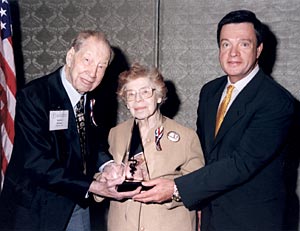Laboratory animal advocate recognized with AVMA Animal Welfare Award
|
| |||
| A V M A A N I M A L W E L F A R E F O R U M | |||
|
For nearly 70 years, Dr. Nathan R. Brewer has worked to effect change in laboratory animal welfare. On Oct. 14 his efforts were rewarded as the veterinary profession conferred on him the AVMA Animal Welfare Award for 2001. A video presented at the award ceremony during the Animal Welfare Forum in Chicago declared: "To the profession, he is the father of laboratory animal medicine and science, and for nearly 100 years, an inquiring mind designed to learn, teach, and promote animal welfare has been the driving force for Dr. Nathan R. Brewer."
Dr. Brewer received his PhD degree in physiology from the University of Chicago in 1936 and his DVM degree from Michigan State University a year later. The war years were spent in private practice in California. In 1945 Dr. Brewer began managing the laboratory animal facilities at the University of Chicago, becoming one of the first full-time laboratory animal veterinarians at any university. At that time, he said, many institutions had fine colonies of laboratory animals, but there were also many problems. Unregulated transportation, inadequate housing, and unethical procurement were among them. Conditions were not only unfavorable for many of the animals; the conditions would often invalidate research results because of problems such as cross-contamination. The first step Dr. Brewer took toward improving the quality of life for laboratory animals was to form an alliance with his colleagues. They convinced purchasing departments at institutions to buy research animals only from recognized sources. Then Dr. Brewer joined the Transportation Committee of the American Humane Association as its biologist and drafted the first regulations requiring humane transport of animals. These regulations eventually became the basis for federal regulations. Dr. Brewer also helped found the Animal Care Panel, now called the American Association for Laboratory Animal Science. He was editor of its journal for 12 years. In addition, he showcased the problems facing laboratory animal care and presented solutions through a Chicago-area lecture series and traveling exhibit featured at meetings of biomedical societies.
As public awareness of laboratory animal welfare issues grew, institutions sought ways to improve their treatment. Many institutions, including the National Institutes of Health, adopted ideas and concepts pioneered by Dr. Brewer. He championed the importance of reducing animal suffering by pretesting procedures before implementing them. The standards and accreditation criteria for laboratory animal facilities that Dr. Brewer developed later in his career provided the basis for the Association for Assessment and Accreditation of Laboratory Animal Care. Dr. Brewer remained at the University of Chicago until 1969 and then spent 21 years as a consultant. He continues his work through library activities, lectures, and writing. His influence is seen in technically sophisticated polymer plastic cages on ventilated racks, HEPA-filtered ventilation systems, and quality-bred laboratory animals cared for by specialty trained laboratory animal veterinarians and technicians. In the forum video, Dr. Brewer said he disagrees with those who charge that "animal experimentation" is unnecessary and cruel. As an example of the need for such research, he contrasted the millions of dogs that died in the 1920s of distemper with the millions who are now vaccinated every year because two British researchers developed a vaccine, using dogs and ferrets. "I think it would be more cruel to have prevented these two men from doing their work," Dr. Brewer said. As an example of the benefits of biomedical research to people, he noted how research using the only model that was found to work, the swamp rat, led to development of the polio vaccine. At the podium, accepting his award, Dr. Brewer made a simple, pointed comment. "First, I'm grateful for this honor given, and I do want to remind everybody that the use of animals is—although we love our animals and want to do the best we can for the animals—it is important that we use animals for some of the important work that has to be done." | |||
 Dr. Nathan R. Brewer, accompanied by his wife, Jean, accepts the AVMA Animal Welfare Award for 2001 from AVMA president-elect, Dr. Joe M. Howell.
Dr. Nathan R. Brewer, accompanied by his wife, Jean, accepts the AVMA Animal Welfare Award for 2001 from AVMA president-elect, Dr. Joe M. Howell.
 Anyone currently involved in research can see from this early 1930s photograph how procedures and equipment have changed over the past six decades. It shows Dr. Brewer, at the start of his career, conducting carbon monoxide research on a dog at the University of Chicago. This work led to his PhD degree in physiology.
Anyone currently involved in research can see from this early 1930s photograph how procedures and equipment have changed over the past six decades. It shows Dr. Brewer, at the start of his career, conducting carbon monoxide research on a dog at the University of Chicago. This work led to his PhD degree in physiology.